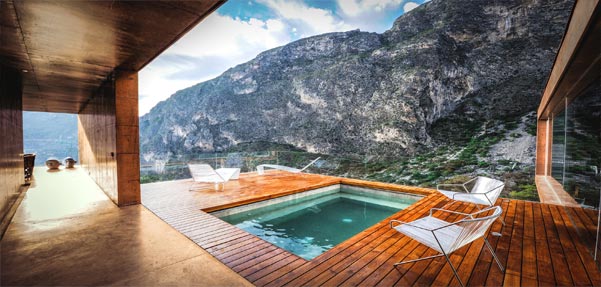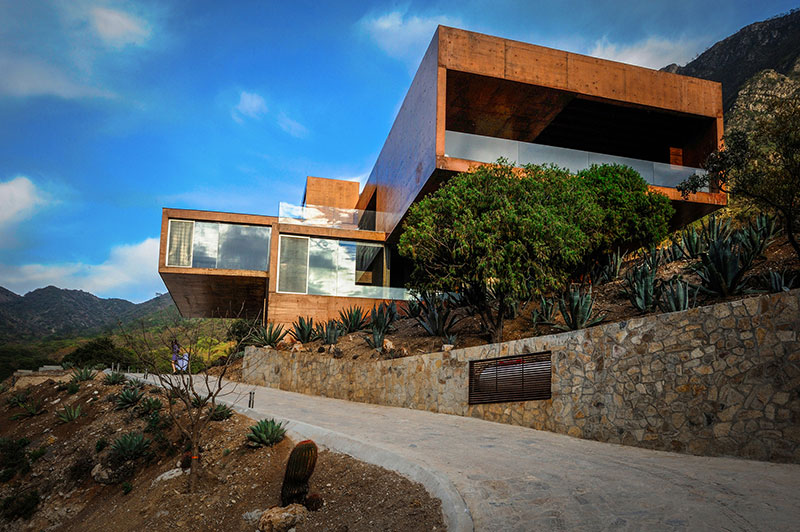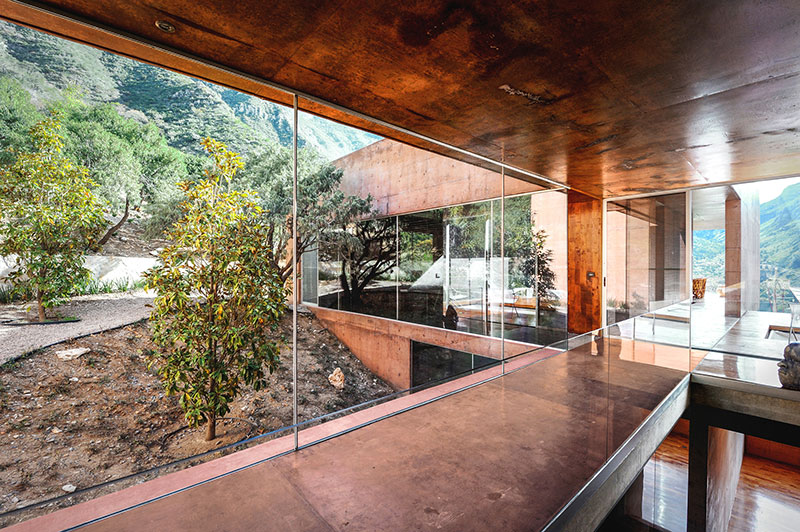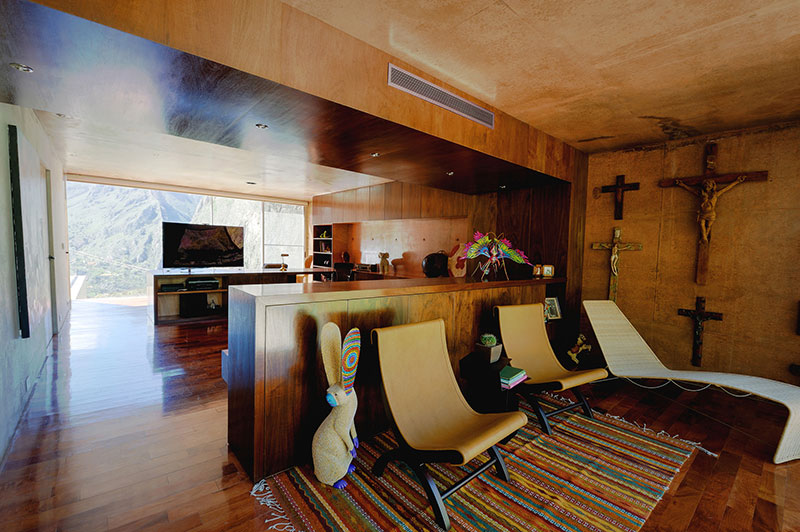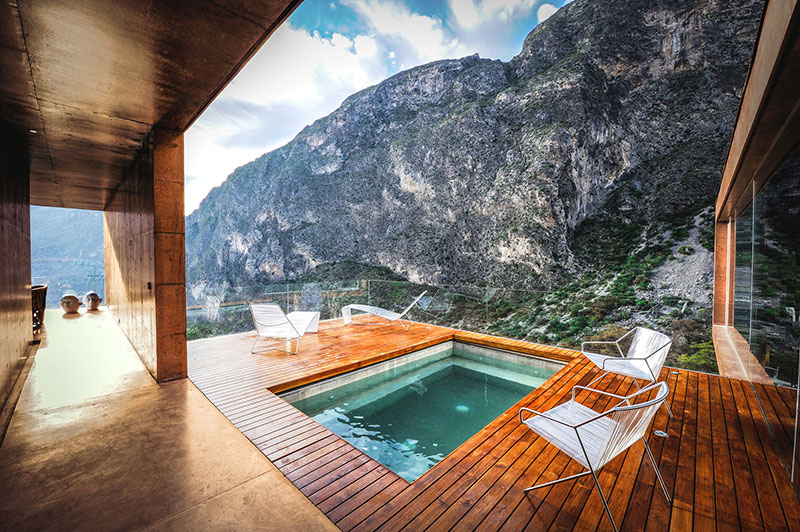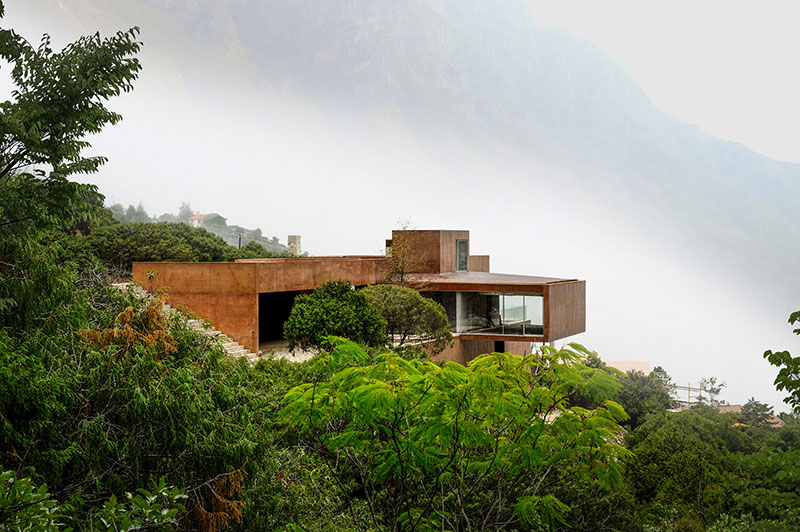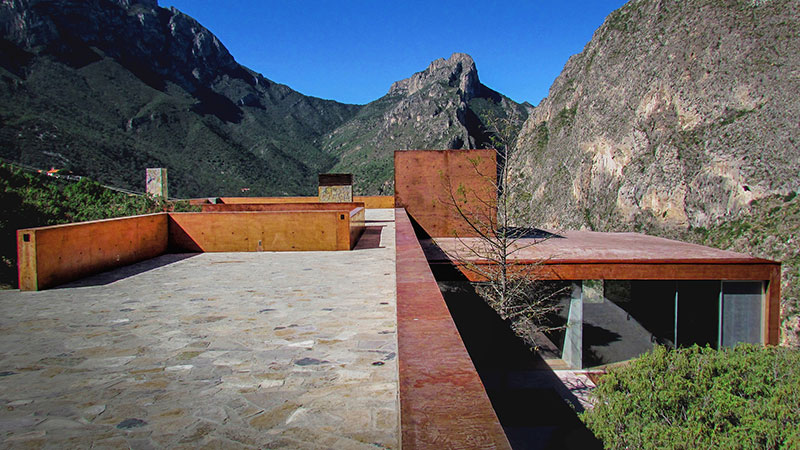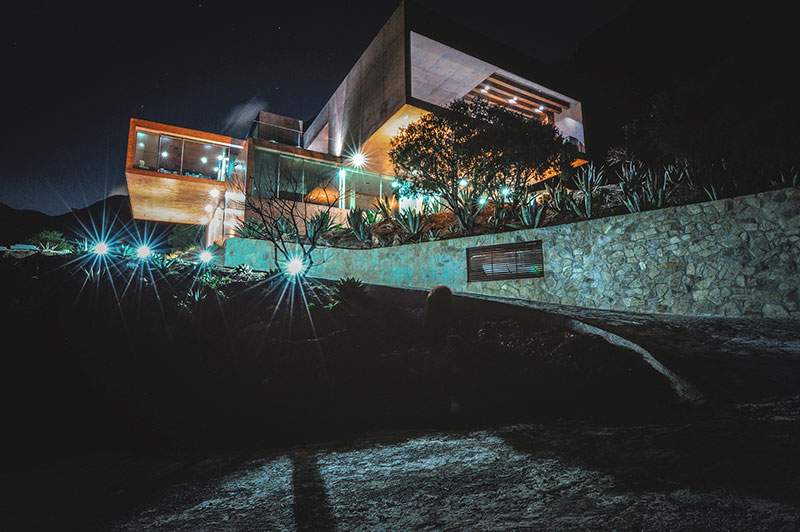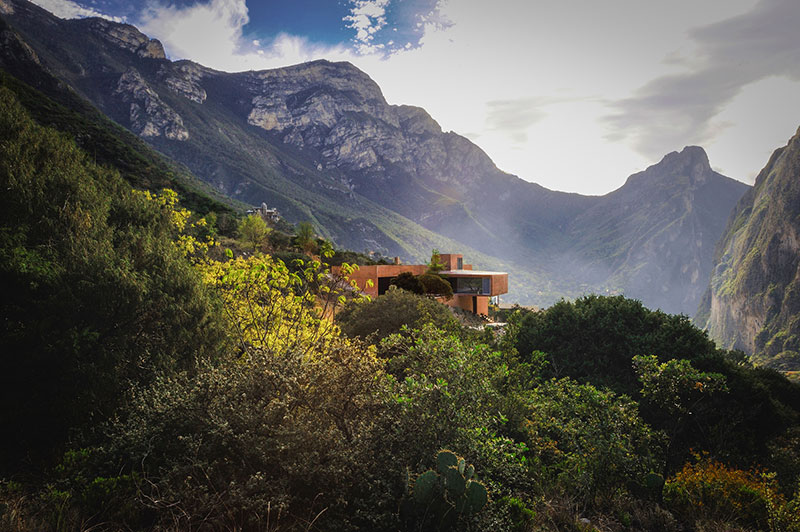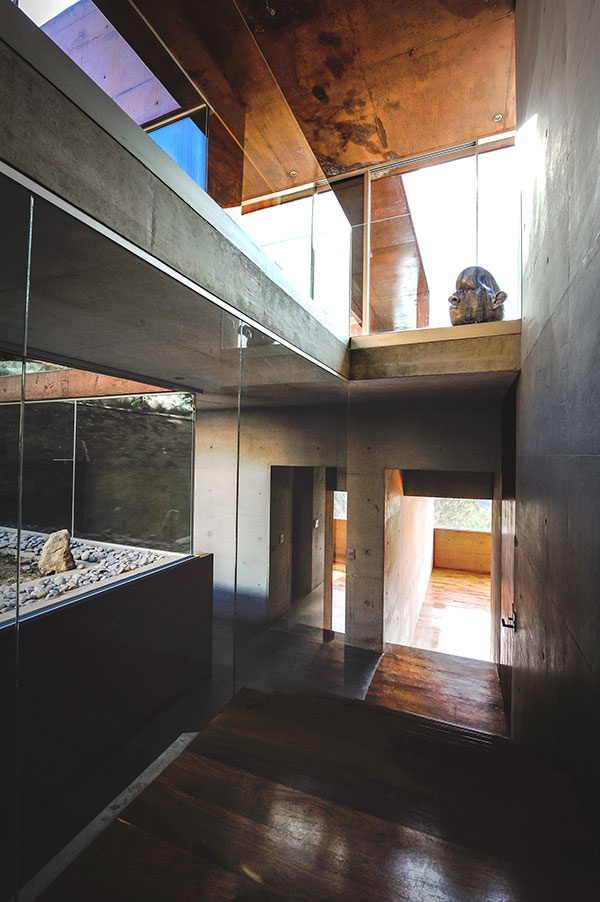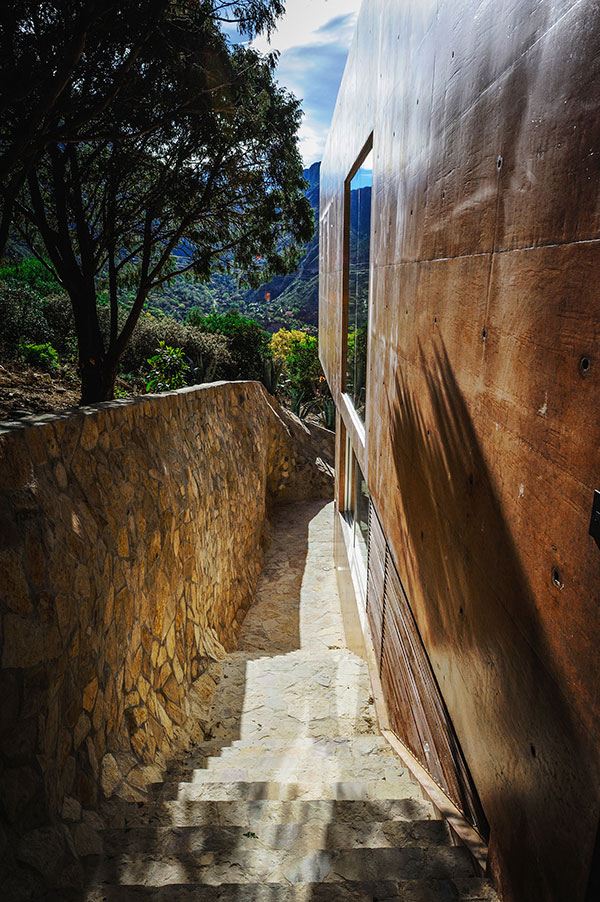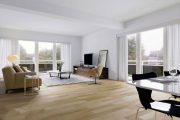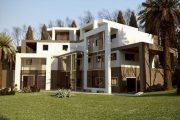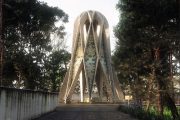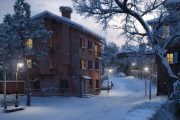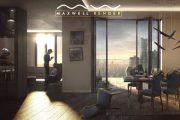این خانه که دارای مساحت ۷۵۰ مترمربع می باشد در مکزیک در سال ۲۰۱۳ ساخته شده است و معماری آن را شرکت David Pedroza Castañeda بر عهده داشته است.
این خانه بی نظیر در منطقه فوق العاده زیبای El Jonuco واقع شده است و افرادی که در این خانه زندگی می کنند می توانند از منظره های دیدنی و جذابِ موجود در ۳۶۰ درجه از اطراف خانه لذت ببرند. این محله محصور شده با کوه ها ما را به یاد شهرهای متعددی از مکزیک می اندازد که کوه های بلند را به دره هایی محدود کرده که انسانها در آنجا مستقر می باشند.
محوطه اطراف این خانه مملو از درختان محلی می باشد که یک چالش مهم را مطرح می کنند. چالش مربوطه این است که باید خانه ای را ساخت که علاوه بر لذت بردن ساکنان آن از منظره کوهها، در عین حال به اکوسیستم موجود احترام گذاشته و لطمه ای وارد نسازد، چرا که رشد افقی درختان سپیدار جلوی منظره را گرفته، و ارائه یک منظره از جنگلِ ستون ها هدف مدنظر معمار نمی باشد. تنها راه حل ممکن این است که بلندی ساختمان به اندازه ای باشد که بر فراز درختان قرار گیرد. شیب ملایم جاده به طبقه همکف منتهی می شود، و ۱۰ متر بالاتر از جاده، تمامی فضاهای ضروری واقع شده است.
برای حفظ فضای سبز موجود، نقشه مربوط به همکف به گونه ای ناحیه بندی شده است که در پیرامون یک گروه از درختان سرو می باشند، زیرا هر سطح در پاسخ به شرایط مختلف هر طرح، به خودی خود ساده و البته برای دیگران متفاوت می باشد.
این ساختمان به سه بخش مختلف تقسیم شده است. اولین بخش شامل گاراژ و فضاهای نگه داری وسایل می باشد. ورودی سالن، اتاق خواب اصلی و راه پله در سطوح پایین تر در بخش دوم ساختمان قرار گرفته اند، در حالی که بخش سوم شامل آشپزخانه، قسمت های خدماتی و فضاهایی برای دور هم بودن می باشد. زندگی در فضای باز در سمت غرب خانه در مجموعه ای از تراس ها امکان پذیر می باشد: دو کوه دیدنی و جذاب که تقریبا در تماس با آن می باشید.
سطح پایین تر به عنوان یک پایه ستون برای طبقه همکف می باشد و حاوی تعدادی از اتاق های قابل بازیافت با مبلمان است که می توان آنها را به اتاق خواب مهمان تبدیل نمود. این طبقه شامل دو اتاق فنی می باشد که فضای پشت بام آن برای لذت بردن از خواب بهاری مناسب می باشد و چشم انداز فوق العاده ای در اطراف آن وجود دارد.
بر خلاف تصویر بیرونی گسترده این خانه، شفافیت شیشه های موجود در فضای داخلی خانه موجب شده که بخشی از مناظر بیرونی زندگی های روزمره قابل مشاهده باشد. پنجره ها با دیوارهای ضخیم، سقف مسطح و تیرهای چوبی همگی نشان دهنده معماری سنتی مکزیک می باشند.
پالت مصالح این پروژه حالت روستایی دارد، ظاهر بی انتها که به عنوان پس زمینه برای اشیا مختلف عمل می کند. اشیا آنتیک و لوکس همراه با مبلمان معاصر در کنار هم قرار گرفته اند و همچنین نقاشی ها، صورتک ها و مجسمه ها توجه ما را به خود جلب می کند. گنجینه های این خانه قبل از اینکه نظر ما را به سمت سناریوی طبیعی در آن سوی شیشه ببرد همواره چشم ما را مجذوب خود می کند.
عناصر مختلف این طرح در مجاورت بخش ها همواره تصویر پیچیده ای که از یک توزیع ساده پدیدار می شود را به تصویر می کشانند. دیوارهای رنگی و کف بسیار عظیم تا پنجره های سقفی منعکس کننده چشم انداز اطراف می باشند.
پله ها و دیوارها با سنگ هایی از زمین و رنگ خاکی هموار شده است، و شکل آنها در تضاد با کوه ها و درختان می باشد. خانه Narigua یک کار سنگی فروتنانه است که در یک چشم انداز تاثیرگذار قرار دارد.
عکس های بیشتر
نقشه ها و ماکت
English version :
Narigua House / David Pedroza Castañeda
Architects: David Pedroza Castañeda Location: El Jonuco, Nuevo Leon, Mexico Architect In Charge: David Pedroza Castañeda (P+0 Arquitectura) Project Area: 750 sqm Project Year: 2013 Photographs: Sofia Flores Chapa Contractor: Paralelo Estándares Globales en Construcción. Ing. Arturo Barbosa, Ing. Hyaell Briones, Arq. Beatriz Chavez. Structure: Ing. Emilio Gonzalez Phase 1 Construction Manager: Punto 3. Arq. Jesus González, Arq. Diego Gonzalez Collaborators And Interior Design: Arq. Adriana Guisa, Arq. Oswaldo Salazar. From the architect. We find Narigua House in “El Jonuco” a beautiful place where we enjoy from 360o of spectacular views. This mountain-enclosed neighbourhood reminds us of numerous Mexican towns where tall mountains limit the valley where its inhabitants settle. Here, its residents live alongside with the typical vegetation and wildlife found in northern México. The site is densely populated by local trees that pose a serious design challenge: A house that enjoys the view of the mountains while respecting the existing ecosystem. Because of the horizontal growth of the cedar trees that block the view, a “forest of columns” is not an option. The only possible solution is to lift the house and make it fly above the tree tops. A mild slope road reaches the ground floor, 10m above the road, where all the essential spaces are located. To preserve the existing greenery the floor plan is divided into zones that get around a group of old cedar trees. Because each level responds to different conditions each plan, in itself simple, is different to the others. The building is divided in three different volumes. The first one contains the garage and storage spaces. The entrance hall, master bedroom and the staircase to the lower level are located in the second volume while the third volume contains the kitchen, service and social areas. Outdoor life occurs on the west side of the house in a group of terraces that overlook the focal point of the residence: two spectacular mountains that almost touch. The lower level serves as a plinth for the ground floor and contains a number of “recyclable” chambers with furniture that allows them to transform into the guest bedrooms. This floor also contains two half-buried technical rooms that free the rooftop to enjoy an enormous belvedere surrounded completely by the landscape. Contrary to its massive exterior image, inside the house the transparency of the glass makes the exterior views part of everyday life. Windows dialogue with thick walls, flat roofs and the timber beams we find in traditional Mexican architecture. The material palette gives the project a rustic, timeless appearance that serves as background for various objects. Antiques live alongside with contemporary furniture while the parallel world of paintings, masks and sculptures claim our attention. The house’s treasures allure our eyes to stay inside before escaping to the natural scenario on the other side of the glass. The different elements of the program, placed in a juxtaposition of volumes define the complex image that emerges from a simple distribution. The coloured walls and enormous floor to ceiling windows reflect the landscape and make the house disappear. When seen from a distance it is easy to mistake Narigua for a geological accident. The roads and walls are paved with the stones of the land and the colours of its dirt, its form contrasts with the mountains and trees. Narigua house is a stone work humbly placed in an impressive landscape.
منبع : archdaily

